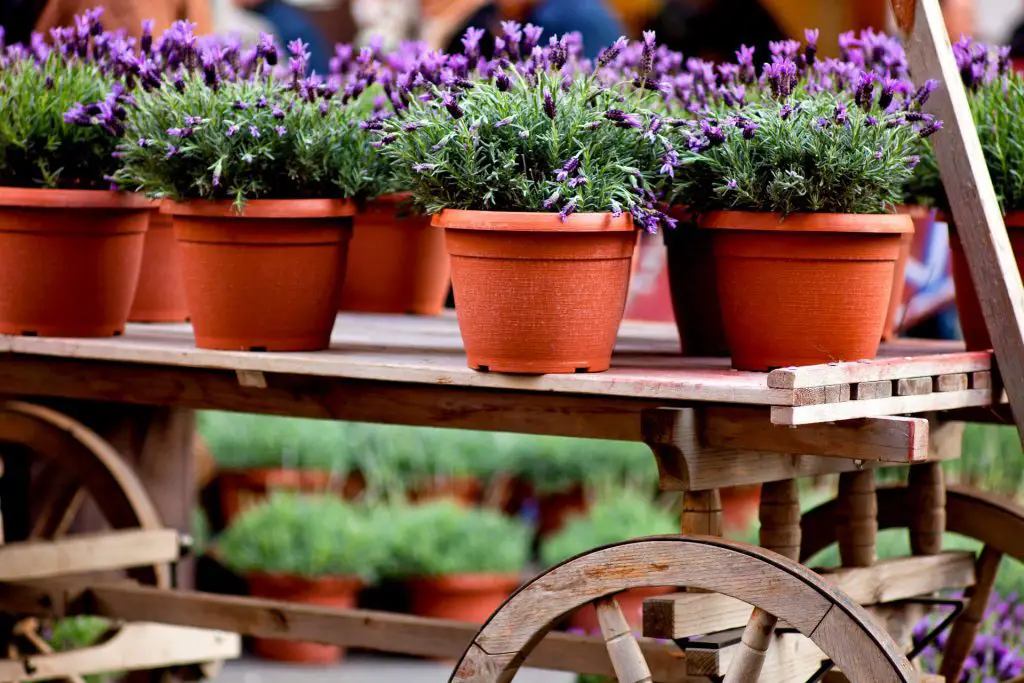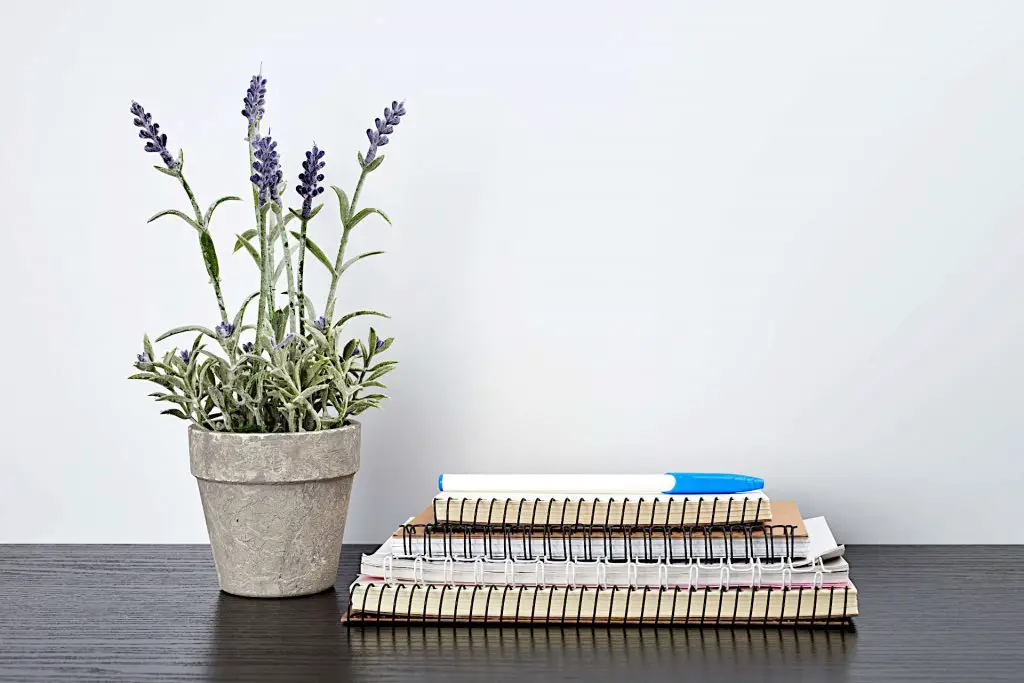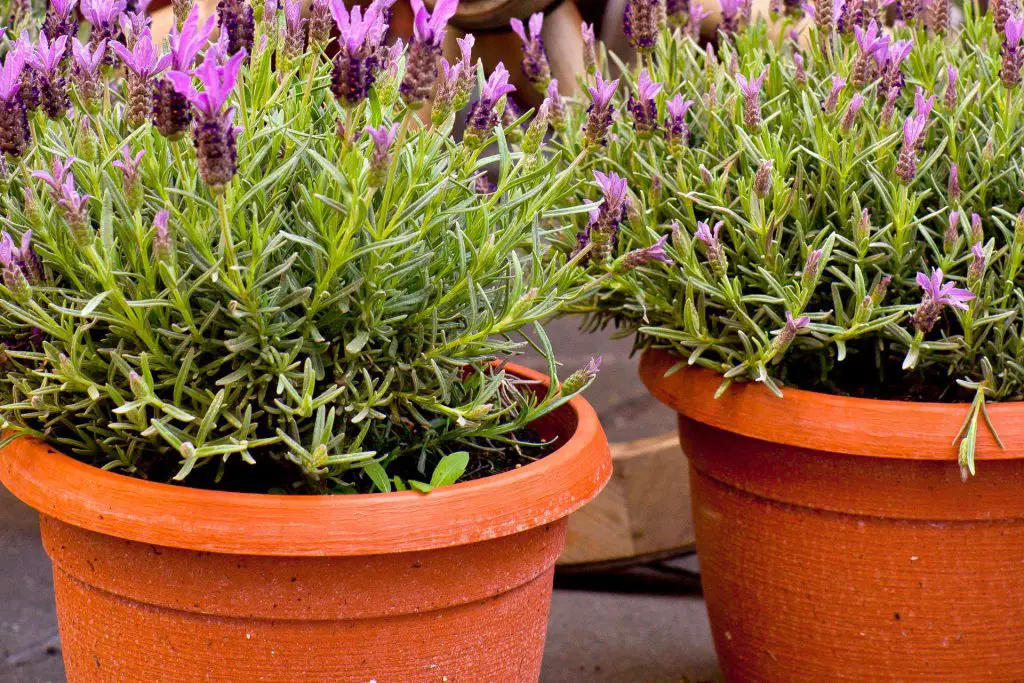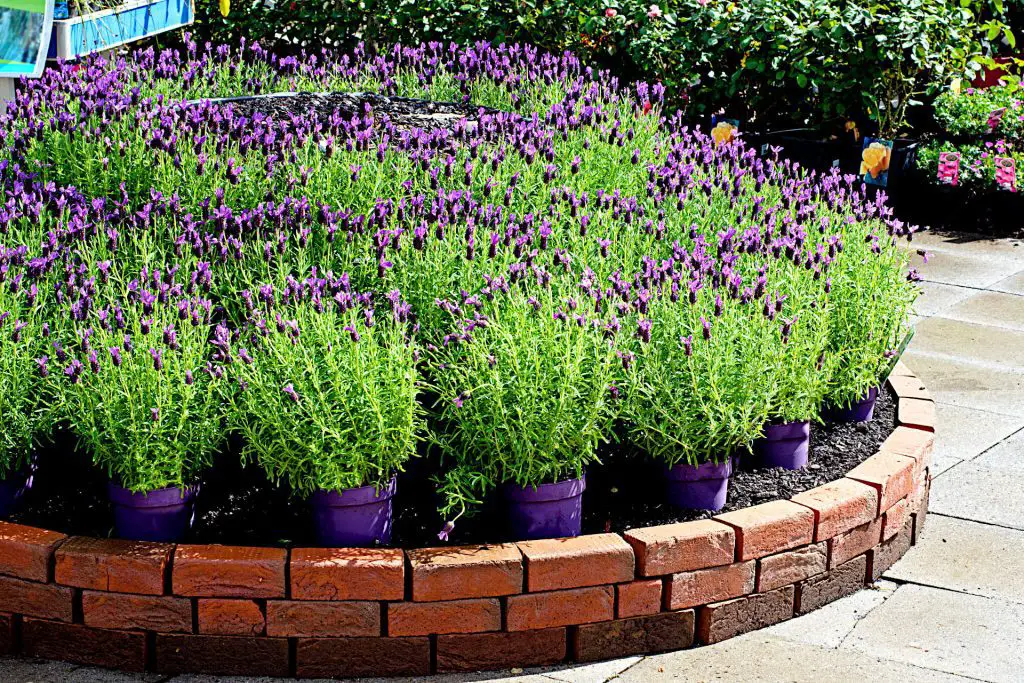Growing Lavender in Pots: The Complete Guide
Growing lavender in pots or planters is a great way to grow and cultivate lavender allowing you the option of growing indoors. Indeed, Lavender is one of the most popular flowers for both indoor and outdoor use. There are hundreds of different species of lavender that grow easily in pots.
However, it’s hard to know what type of plant will thrive best when growing in a pot or container, particularly if you intend to leave the pots outside. Factors such as climate pot type and size can be important in giving your lavender the best chance of thriving.
That’s why we’ll be covering everything from choosing species to caring for new plants when they are grown from seed or growing them from cuttings. We will look at covering all the most important aspects of annual care, like harvesting and pruning, when growing lavender in pots.
Quick-Start Guide to Growing Lavender in Pots
- Select compact, container-friendly lavender varieties.
- Use large pots with excellent drainage.
- Plant in fast-draining soil mixes.
- Give lavender at least 6 hours of sunlight per day.
- Allow soil to dry out between waterings.
- Prune annually to shape plants and encourage blooms.
- Overwinter in a sheltered spot.
Choosing the Best Lavender Varieties for Pots

Lavender is native to the Mediterranean and is a member of the mint family. With over 40 species of lavender, it can be tricky to select the best varieties for container growing. So, which one is the best for your needs? Here are some top picks:
| Type of Lavender | Description |
|---|---|
| English Lavender | – Hardy, easy to grow, and very fragrant. |
| – Compact varieties like Munstead, Hidcote, and Twickel Purple are ideal for pots. | |
| Spanish Lavender | – Heat and humidity tolerant. |
| – Try Lady Lavender or Goodwin Creek Gray. | |
| French Lavender | – Beautiful blooms on compact plants like Jean Davis and Provence. |
| Dwarf Lavender | – Small, bushy plants perfect for pots like Peter Pan, Little Lottie, and Blue Cushion. |
| Phenomenal Lavender | – This hybrid has the best traits of English and French lavender. |
English Lavender
English lavenders (Lavandula angustifolia) are hardy, easy to grow, and very fragrant. They are one of the most popular types of plants for containers.
Look for compact English lavender varieties that reach 16-28 inches wide at maturity. Some top picks are:
- Munstead – Dwarf, early blooming lavender that grows 18 inches tall. It has pretty violet-blue flowers on silver-grey foliage.
- Hidcote – A compact 12-18 inch tall variety with deep violet-blue blooms and robust fragrance. It’s an ideal size for pots.
- Twickel Purple – A dwarf variety growing to only 10 inches tall but 18 inches wide. It has vivid violet-purple flowers and sturdy, gray-green leaves.
- Jean Davis – Grows 12 inches tall but spreads 24 inches wide. It offers profuse pink flowers on compact silvery green foliage.
- Little Lady – One of the smallest varieties at 8 inches tall x 12 inches wide. It blooms prolifically with violet flowers.
English lavenders bloom in summer and are quite hardy, making them excellent container choices. Plant them in full sun.
Spanish Lavender
Spanish lavenders (Lavandula stoechas) are tender, meaning they need more frost protection. But they tolerate heat and humidity well.
Good Spanish lavender varieties for pots include:
- Goodwin Creek Grey – A compact plant that reaches 24 inches tall x 18 inches wide. It has showy bicolored purple and white flower spikes.
- Lady – A dwarf variety growing to only 8 inches tall x 12 inches wide. Its compact size and profuse purple blooming make it ideal for pots.
- Anouk – Mid-sized at 18 inches tall and wide. It boasts large royal purple flower heads on strong silvery green foliage.
- Silver Anouk – Very similar to Anouk but with bright white variegated leaves that contrast beautifully with the rich purple blooms.
Spanish lavenders start blooming in late spring and are great for warm, humid climates if winterized indoors. Site them in full sun.
French Lavender
French lavenders (Lavandula dentata) produce compact mounds blanketed with stunning flowers and aromatic foliage. They work beautifully in pots.
Recommended French lavender varieties include:
- Jean Davis – Only grows 12 inches tall but spreads up to 2 feet wide. It offers masses of pink flowers with serrated, green leaves.
- Provence – Grows 18 inches tall x wide. Features dense lavender-blue flower spikes that bloom all summer long with a sweet fragrance.
- Grosso – A prolific bloomer growing 2 feet tall x wide. It has bold violet-blue flower heads on fragrant silvery green leaves.
- White Provence – Similar size and form to Provence but with pure white blooms instead of purple.
French lavenders are only semi-hardy so need winter protection in cold climates. Give them full sun and well-drained soil.
Dwarf Lavender
For the smallest pots, look for dwarf lavender varieties. Their compact size makes them perfect choices.
Some top compact varieties for containers include:
- Peter Pan – Grows only 10 inches tall and wide. It offers masses of violet flowers and neat mounding form.
- Blue Cushion – This dwarf lavender reaches just 6 inches tall x 12 inches wide. It produces prolifically all season.
- Mini Blue – One of the tiniest at 8 inches tall and 12 inches wide. The abundant blooms give great impact for the small size.
- Little Lottie – Extremely compact at 5 inches tall x 10 inches wide. It’s covered in flowers that attract pollinators.
- Twinkle Purple – Another minuscule variety at 6 inches tall and 10 inches wide. It has vivid violet blooms.
Dwarf lavenders are ideal for window boxes, edges, and mixing into container plantings. Site them in full sun and well-draining soil.
Phenomenal Lavender
Phenomenal lavender (Lavandula x intermedia ‘Phenomenal’) is a hybrid cross between English lavender and French lavender. It combines the best traits of both.
What makes Phenomenal ideal for containers is its:
- Compact, rounded form growing 2 feet tall and slightly wider.
- Vibrant violet-blue flower spikes that bloom prolifically from early summer into fall.
- Strong fragrance – it’s one of the most aromatic lavender varieties.
- Good cold hardiness surviving into zone 5 winters.
Phenomenal lavender is excellent for herb gardens, borders, and containers. Site it in full sun and well-drained soil.
Consider the mature size, hardiness, and growing habits when choosing lavender varieties for your climate and space.
How to Plant Lavender in Containers
You can grow lavender from, seed, or from cuttings and rootstock.
Choosing the Right Pot for Growing Lavender?
There are a number of factors you should consider when choosing the right type of bot for your lavender plants. The two most important are size and shape.
Best Pot Material for Growing Lavender in Pots
There are of course numerous types of pots made of anything from plastic to terracotta, glass to metal, and synthetic materials to natural materials. Whilst lavender will survive in pretty much any some materials suit it better than others.
The best types of pots for growing lavender are the ones that are made from clay. Clay pots are porous and allow water to drain out more easily, so they allow your lavender plants to be watered more frequently than other pot types. Their porous nature allows air to move through them more easily and helps prevent root rot
Clay pots also retain heat better than other types of pots, which is beneficial for growing warm-climate plants such as lavender. If you don’t have access to clay pots, plastic or terracotta pots will also work well for growing lavender.
Best Size of Pot to Grow Lavender

The size of the pot that you use to grow your lavender plant is also important. Whilst the varieties will play an important part lavender has an extensive root ball.
The best size of pot to grow lavender in terms of root ball size is at least 4 inches in diameter. This size allows for a good amount of root development and for the top to be lifted so that it can be pruned and shaped.
The smaller the pot is, the more likely it will be that the plant will need to be bottom-trimmed because there isn’t enough root mass to support itself. The larger the pot, the more room there is for roots to grow and spread out away from the center point of the plant.
As the plant matures you may well need to repot it into a larger container. For mature plants particularly English lavender pots of between 8 to 12 inches are more suitable.
The size of the pot in which you grow lavender can affect the soil nutrients and moisture that is available. Although not overly requiring too much of either it should have enough volume to hold sufficient moisture to avoid too much watering.
It should also have enough depth so that your plant doesn’t sit too high off of the surface when watered or fertilized. A 4-inch diameter pot with 2 inches depth should work well for most plants like lavender.
How to Grow Lavender from Seed in a Pot

Lavender is a great plant for pots, and you don’t need to rush the process. It’s not like you can just plant it in the ground and expect it to grow like crazy. Lavenders thrive in warm weather, but they also need some protection from cold nights.
Growing lavender from seed takes time and care, but it’s rewarding to watch your plants flourish.
- Start seeds 8-12 weeks before your last expected frost. Sow seeds in starter trays using a sterile seed starting mix.
- Cover trays with plastic wrap and place somewhere warm (65-70°F). Bottom heat, like a propagation mat, speeds germination.
- Once sprouted, move to a sunny spot. Thin seedlings to 1-2″ apart. Transplant into 3-4” pots once they develop 2-4 true leaves.
- Harden off plants for 1-2 weeks before moving outdoors. Gradually increase sunlight exposure and wind.
- Transplant seedlings into at least 10” pots. Use a sandy potting mix with excellent drainage.
- Grow on in pots through summer, pinching tips to promote bushiness. Move indoors before frost.
With careful attention, you can grow lavender successfully from seed. Patience is required as most plants will not flower in the first season.
How to Grow Lavender from Cuttings in A Pot
Propagating lavender from cuttings is a great way to replicate a plant you love. When you want to start new plants from cuttings or rootstock (also called balled-and-burlapped stock), be sure that you select healthy shoots with at least two leaves on each stem.
- Choose a pot size. A pot that is 5-8 inches in height and at least 5 inches wide will provide your plants with enough space.
- Take 3-4” tip cuttings from new growth in spring using clean, sharp shears. Remove flowers and flower buds.
- Dip cut end in rooting hormone powder to speed root formation. Allow the end to dry before planting.
- Fill 3-4” pots with sandy potting mix, water well, and poke a small hole for each cutting.
- Insert cuttings so at least 2 leaf nodes are buried. Firm soil gently.
- Place in a warm spot out of direct sun, 70 degrees Fahrenheit or warmer for optimal growth. Keep soil slightly moist but not soggy until rooted.
- Once rooted, pot up into larger containers filled with well-draining soil. Gradually acclimate to full sun.
With proper care, lavender cuttings will root in 4-8 weeks and grow into lush, blooming plants. Take lots of cuttings for the best success rate.
Caring for Lavender in Pots
With proper care, potted lavender will thrive key points are:
- Sunlight – Needs at least 6 hours of full sun per day. More sun = more blooms.
- Watering – Allow soil to dry out between waterings. Less in winter.
- Temperature – Prefers warm weather. Move pots to a sheltered spot in winter.
- Fertilizer – Use a balanced fertilizer at half-strength in spring and summer.
- Pruning – Trim lightly in spring and cut back after flowering to encourage growth.
Monitor your lavender’s needs and adjust care accordingly. Well-drained soil and lots of sun are vital.
Watering Needs of Your Potted Lavender
Lavender is a drought-tolerant plant that requires little watering. The best way to water your lavender is by soaking the soil at least once a week or when it feels dry and hard. If your plants are getting too much sun, they will need more frequent watering than those in shadier spots.
The best time to water is in the morning when plants are most likely to absorb water. Lavender needs good drainage. If the soil is too porous, it will not hold enough moisture for your lavender plant.
Fertilizer Needs
Because lavenders thrive in sandy soils with low nutrient content, they do not require too much feeding or fertilizing. You should fertilize with a half strength balance fertilizer in the spring and summer.
Over-fertilizing your lavender plant will increase the length of its stems, and reduce the size of its flowers, often diminishing their aroma and making them less attractive.
Temperature and Humidity
Lavender plants grow best in a warm, dry climate with high humidity. As such Lavender is a plant that thrives in indoor conditions so long as there is adequate sunlight, good drainage, and a gentle temperature. It can be grown outdoors in regions with cold winters, but it also does well indoors. The ideal temperature for lavender is between 60 and 80 degrees Fahrenheit (16-27 degrees Celsius).
This plant prefers full sun but will tolerate partial shade. In areas where there are no direct rays of sunlight, you can position the plant in a window or under an artificial light source such as a fluorescent tube or incandescent bulb.
Growing Lavender in Pots Outside

If you are growing your lavender in pots outside then the choice of lavender before is more important, particularly if you are going to overwinter the lavender outside. It is important to choose a variety that is suitable to your natural climate conditions.
As we have mentioned varieties such as English lavender are by far the hardiest species. French and Spanish lavender are far less hardy, struggling if the temperature approaches freezing.
The best alternative to English Lavender in colder climates is the Phenomenal French hybrid. It is better suited to surviving winter outside than other French or Spanish lavender species.
If you have French or Spanish lavender in pots outside and you experience unexpected cold snaps then you should look to insulate the plants if the temperature falls close to freezing or you suffer unexpected frosts.
How to Prune Your Potted Lavender Plants?
Pruning lavender is an important part of its care. You can prune your lavender plants to encourage new growth, or you can do it to keep the plant healthy and looking nice.
Here are some tips:
- Prune lightly in early spring by trimming 1-2” off the tops to shape the plant.
- After flowering finishes in summer, cut back flower stalks by 1/3 to encourage new growth.
- Remove any dead or damaged branches year-round to maintain health.
- Every 2-3 years, cut woody plants back further in spring, leaving just 2” of green growth to rejuvenate.
- Use clean, sharp pruning shears to avoid damaging stems. Dipped in isopropyl alcohol prevents disease spread.
- Always prune just above leaf nodes or buds. Cut at an angle to allow water to run off.
- Remove trimmed debris and destroy any plants with signs of disease to prevent spreading.
Proper, timely pruning keeps lavender full, compact, and flowering beautifully in pots for years of enjoyment.
Cut back any dead or dying branches from the crown of your plant. This will encourage new growth in those areas and keep your plant healthy.
In most cases, it takes two years for a lavender plant’s growth rate to slow down dramatically due to over-pruning or too much sunlight exposure during its early stages of development. This means that if your lavender has been growing for two years at about five inches per year and then suddenly slows down after two years, then that may be an indication that it has reached its maximum height (and growth rate).
Troubleshooting Common Lavender Problems
Issues with potted lavender often stem from cultural problems:
- Poor drainage – Repot in new, fast-draining soil. Improve drainage holes.
- Overwatering – Allow soil to dry out further between waterings.
- Underwatering – Increase frequency, but avoid overcompensating.
- Insufficient sunlight – Move pot to a sunnier location.
- Rootbound – Repot in a larger container to allow roots to spread.
- Woody growth – Prune annually to encourage new growth.
With good care matching its needs, lavender is quite hardy and trouble-free in pots.
Final Thoughts: Growing Lavender in Pots
Growing lavender in pots is an easy way to enjoy this aromatic plant in your home without having to worry about the plant becoming invasive. Pots are a good choice for the windowsill gardener.
As with all plants, there is a great variety of lavender in the world. It’s important to know which variety is best for you, although the advantage of an indoor is this is less important as you have more control over growing conditions.
You can grow lavender plants from seed or from rootstock. Lavender is hardy but does not like being transplanted or moved often, so find a place in your yard that is nice and sunny and allows you to leave the plant alone for at least 2 years.
Commonly Asked Questions
What size pot does lavender need?
Use at least a 12-16-inch wide container. Bigger pots are needed for larger lavender varieties.
How often do you water lavender in pots?
Wait until the soil is dry 2-3 inches down before watering again. Less water is needed in winter.
Should I fertilize potted lavender?
Use a balanced fertilizer at half strength once in early spring and again in summer if needed.
How do I overwinter lavender in pots?
Move pots to a sheltered spot like an unheated garage once temperatures drop below freezing. Water minimally throughout winter.
Why is my lavender dying in a pot?
This is usually due to overwatering, insufficient sunlight, or inadequate winter protection. Improve drainage and care to bring it back to health.
When should I prune potted lavender?
Prune lightly in early spring. Cut back stems by 1/3 after peak flowering to promote new growth.
